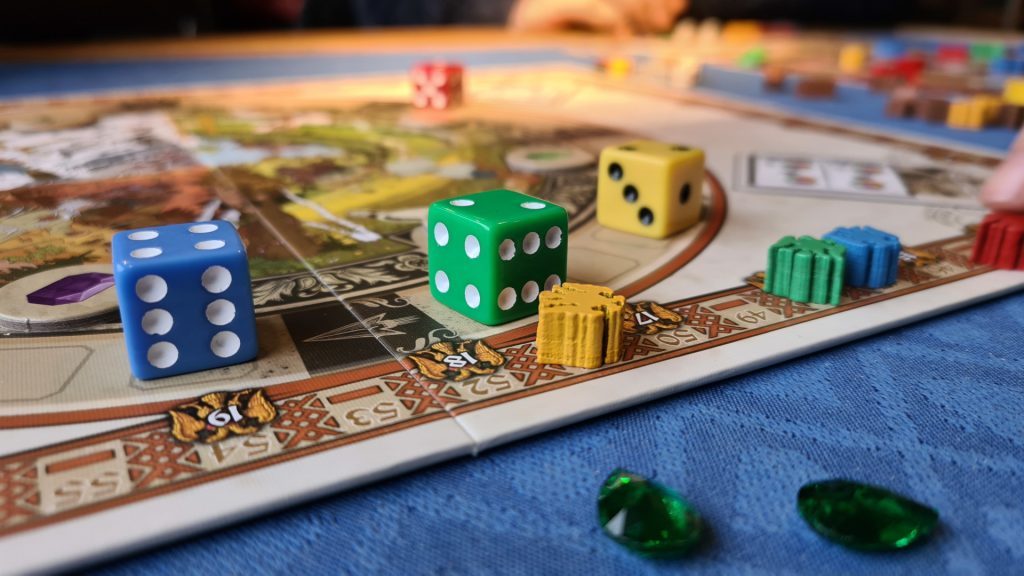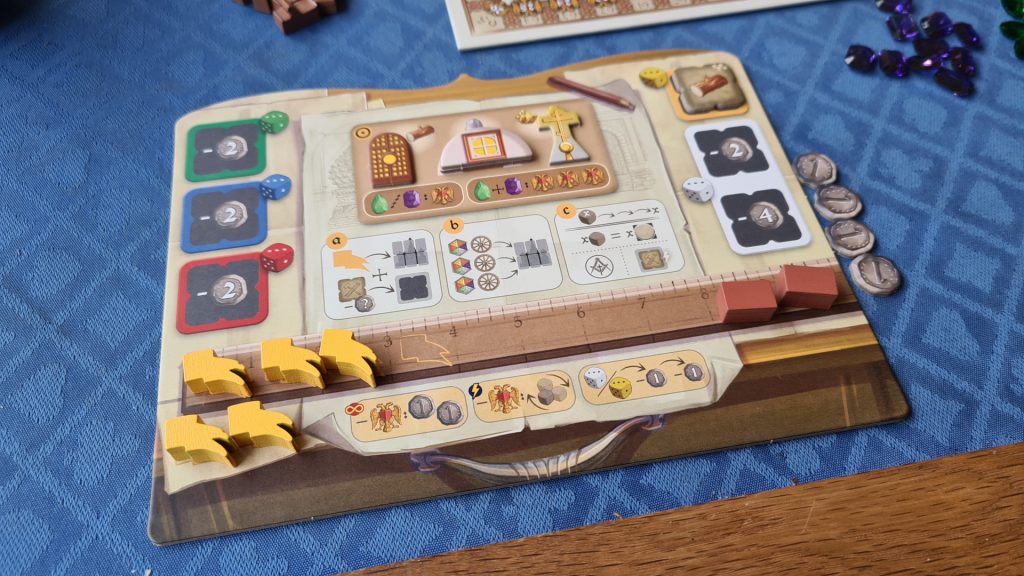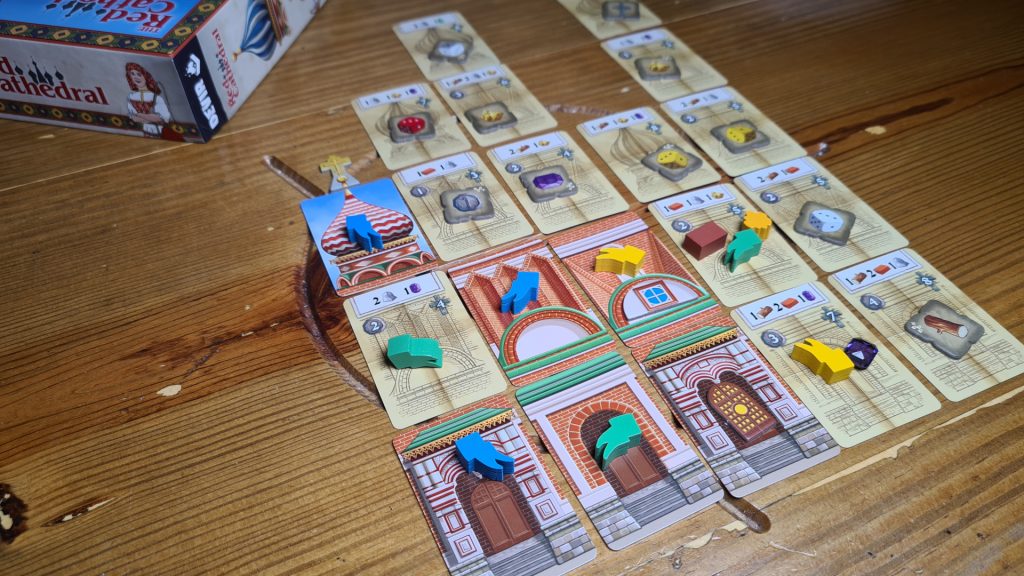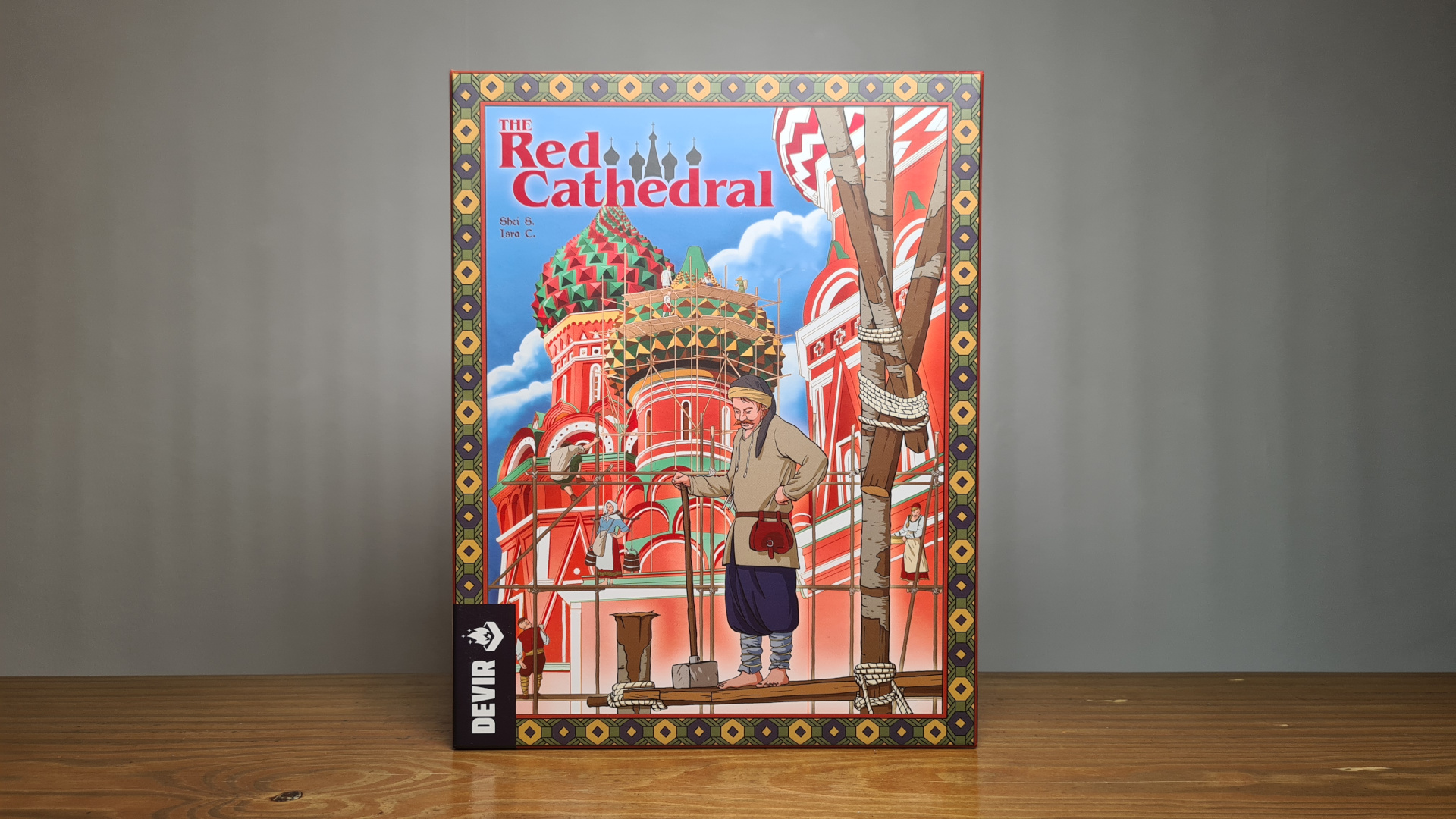The Red Cathedral is the new “Euro” style board game from publisher Devir, featuring dice and a rondel. Designed by Isra C. and Shei S., featuring artwork by Chema Román and Pedro Soto, the game sees 1 – 4 players helping to build St. Basil’s Cathedral. Attempting to please the Tsar, players will be collecting resources, carting them to the build site and constructing parts of the cathedral and fancy ornaments to adorn it. However, will players want to keep becoming architects? Let’s find out!
With Tsar Ivan the Terrible wanting architects to construct St. Basils, players will set up the game by placing out cathedral cards based on a randomly selected building plan card. These are flipped to their building cost side, with a random workshop tile added to each. Players each choose a colour and take their specific player board and flag tokens. Randomising the resource tokens and influence cards on the main board, the dice are rolled and added to the rondel starting with the space which features the recognition point symbol.
On a turn the active player will do one of three possible actions. The most commonly used action is to move a die around the rondel – always following the direction of the arrows. Choosing one of the dice, the player moves it as many sections around the board as pips shown on it. Note that if that section is full of three dice then the move cannot be made. The section and the number of dice there then determines what the player gains. Multiplying the resources shown on the section’s token by the number of dice there equals what the player receives – so often players will try to exploit this to get more on a single turn. All resources are added to the player’s inventory, with any resources they don’t have room for lost.
Each section is part of a pair, with the board split into quarters. Each quarter has an influence card, with the player also able to trigger one of the two abilities after moving the die. These can offer extra resources, the chance to sell some for rubles and much more. To help players get the resources they need, they can increase the number of sections moved by two of the dice. Everyone can pay to move the white die further, though each player can also pay to move their coloured dice more sections around the rondel, at a cost of 1 ruble per section. Importantly, if you have moved a die at the end of your turn you reroll all dice in the moved to section.

Instead of moving a die the player could claim a cathedral card. Taking one of their six flag tokens, preferably from their inventory to free up a slot, the player places it onto an unclaimed cathedral card. Taking the workshop tile on the card, the player can pay to add it to their board and then gain bonuses when using the dice they assigned it to. Each cathedral card denotes the resources needed to build it, as well as the points and potentially rubles awarded when it is built.
To get the resources to the cathedral cards players will need to take the build action. This enables the player to move up to 3 resources of any type from their inventory to an unbuilt cathedral card they have claimed. When all of the required resources have been delivered to a cathedral card it is constructed. Flipped over, the resources are returned to the supply, with the players flag remaining on the completed card.
Green and purple gems can be used along with wood, stone or gold to decorate constructed tower sections with doors, windows or crosses respectively. Carting off these to any completed (but not already decorated) cathedral section allows the player to build the decoration, netting them instant prestige points. On top of this, it also helps players line up for majorities in the end game scoring. Ornaments can be built without gems, or just one colour, though this isn’t worth as much points wise.
The Red Cathedral features two types of points, recognition and prestige. Referred to at the start of the game as big and little points, by the end each step is one of each. Still, at the start of the game players need to gain 3 – 4 recognition to move one prestige step around the score tracker. Some things will award prestige, while others “only” recognition points. There are some bonuses such as being able to fall back on the prestige track to gain 2 rubles for free, perfect for when you’re about to do a big jump. Importantly though, at the end of the game only prestige points matter, the recognition points are just to give smaller bumps around the track.

So when does the end trigger? When one player has built their 6th cathedral card the end is triggered – netting that player 3 prestige for doing so. Everyone else gets one final turn before scoring. At this point players trade in materials and rubles for points at a rate of 5:1 and determine contributions. Summing up the value of each tower individually, completed sections are worth 2 prestige and decorations are worth 1 prestige. Counting built sections and ornaments the player who did most scores the full amount. Second place then scores half rounded down, third half that again and so on. Adding it all up, whoever has the most prestige wins.
Featuring dice there is an element of luck and something for players to tactically react to. If the dice aren’t in the right places, with the right number of pips, then players have to tweak and change their plans. There are ways to mitigate the luck though, so it’s not just spoiled plans left, right and center. Each player having their own coloured dice and the ability to pay to move it or the white die further is part of this. The more impactful part are the workshop tiles that trigger when the specific dice are moved. These bonuses can gain the needed resources and such, making the individual dice less important.
They don’t however make the dice insignificant. Moving a dice that someone else was wanting to use can disrupt their plan. Even moving a dice into a zone sees them all re-rolled and this can spoil their plans just as much. This can cause a bit of a problem when it comes to planning ahead. As when the dice move they are rolled and it can cause others to be rolled there’s little chance of knowing what the board situation will be until it’s actually your turn. Any player that suffers from analysis paralysis therefore will drag out their turns. Simply re-rolling only the moved dice would certainly have limited this, as it can slow the game down to a plod.

Variety is instilled into The Red Cathedral in numerous ways, not only from the rolling of the dice. How the cathedral cards are setup makes each tower more or less valuable to control. The influence cards in play can offer ways to get recognition points, cart materials to the cathedral and even change how easy it is to get your hands on resources. While the influence cards might change the routes to do actions they don’t change the overall experience, so it’s not like relearning each play. They are enough though to keep the plays feeling fresh and are another aspect to adjust your plans to during a game.
The Red Cathedral is a rather good looking game in its own way. The cards that create St. Basils really represent the towers slowly being constructed. While the cards aren’t built up vertical it still is a striking part of the table. The main board however is less inspiring, and despite the art it does little to invoke thoughts of the construction process. Still, it’s functional and it’s clear where the different coloured, solid, dice sit. The resources are uniquely shaped rather than just cubes adding a bit of flair. The final components, the ornaments, are great additions gameplay wise but also just add those extra touches visually, to give the game that special something.
The Red Cathedral is a puzzle that won’t be forever cracked. What may ease the path to victory in one game might be shuffled out in the setup for the next game. Each action might be small, yet even moving a single die can result in a shed load of resources filling your inventory, even before the bonuses from workshop tiles and extra actions of influence cards are taken into account. St. Basils is built slowly throughout the game and each section feels like you’re progressing forward, not only for in-game scoring but the tower majorities at the end. If you are someone that suffers from calculating each and every outcome of choices, then this experience may not be for you. The Red Cathedral constantly offers players choices that matter and possibilities to exploit the dice and mitigate luck, which means it is easy to see many euro gamers enjoying being architects for the Tsar!
(Editor’s Note: The Red Cathedral was provided to us for review by the publisher. More details can be found on the on the Thames and Kosmos store.)

